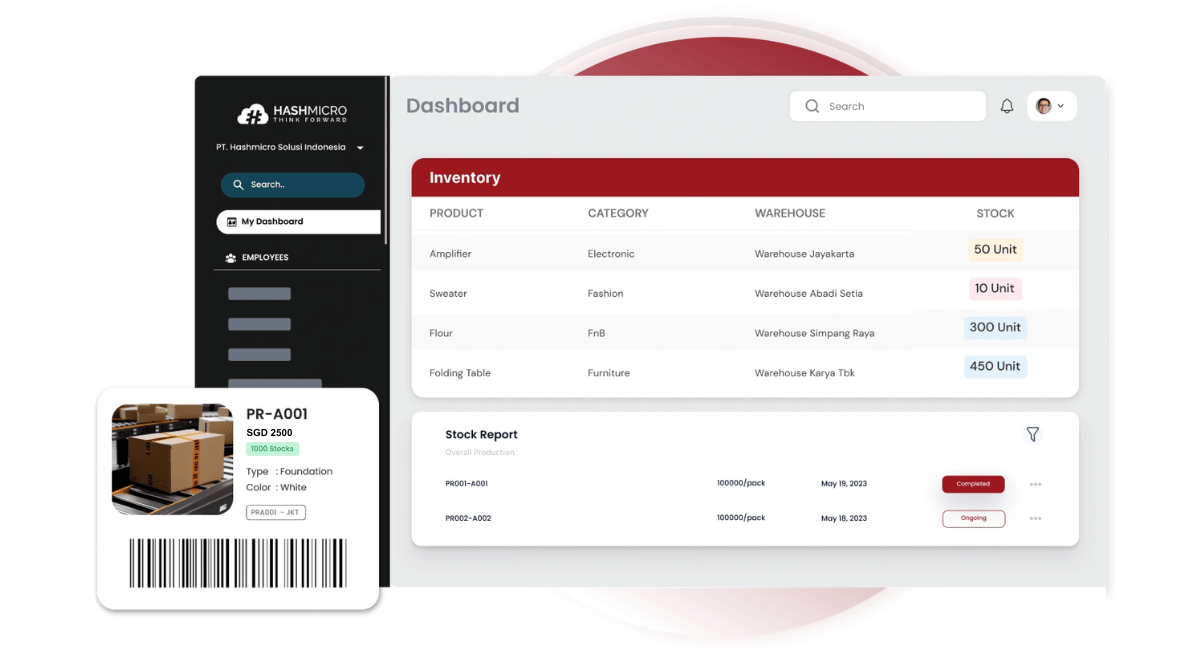Inbound logistics is receiving, storing, and managing incoming materials, while outbound logistics focuses on processing orders, packaging, and delivering finished products. Logistics is key to business success as it ensures products are smoothly transported from suppliers to customers.
HashMicro’s Inventory Management Software automates stock tracking, provides real-time updates, and streamlines inbound and outbound logistics. It helps reduce errors, improve efficiency, and enhance overall supply chain performance.
Understanding inbound and outbound logistics improves supply chain management. This guide covers what is inbound and outbound, the processes, and how inventory management systems help. Mahalaga ang maayos na paghawak ng logistics para sa tagumpay ng negosyo.
Table of Contents
Key Takeaways
|

Inbound and Outbound Logistics Definition
The first step in managing a supply chain well is to understand what inbound and outbound logistics mean. These two parts have different but connected roles in making sure products are delivered smoothly.
Once we understand these ideas, we can see how their main tasks differ and how they help make logistics work better overall.
What is Inbound Logistics?
Inbound logistics is about receiving, storing, and handling supplies. This includes bringing raw materials from suppliers to warehouses and keeping them until they are needed.
Good inbound logistics make sure products are ready for production or sale without delays. It also helps manage stock levels to ensure having enough or too little, which can mess up schedules and raise costs.
In the Philippines, inventory management systems are crucial for improving inbound logistics. These systems automatically track supplies, manage stock levels, and predict needs based on past data and market trends. Read this article to learn how to maximize the benefits of an inventory management system.
By using such a system, businesses can make better use of warehouse space, reduce mistakes, and keep materials flowing smoothly for more efficient operations.
A manufacturing company sourcing raw materials from multiple suppliers provides an example of inbound logistics. For instance, a car manufacturer receives steel, rubber, and electronic parts from different locations.
What is Outbound Logistics?
Outbound logistics refers to the process of moving finished products from the warehouse to the customer. This includes handling orders, packaging, shipping, and delivery.
Efficient outbound logistics is important for meeting customer needs and ensuring deliveries are on time. It involves working with shipping companies, planning delivery routes, and managing returns if needed.
Inventory management software like ERP for packaging industry or manufacturing automates the order process, tracks stock levels in real-time, and ensures accurate product delivery to the correct locations. This reduces mistakes and speeds up deliveries, making customers happier.
An outbound logistics example can be seen in a retail company that ships products directly to customers. After receiving an order, the company processes it, packages the items, and arranges transportation for delivery.
How Inbound and Outbound Logistics Are Different
After explaining the basic ideas, it’s important to explore the differences between inbound and outbound logistics. Understanding these differences helps clarify their specific jobs and goals in the supply chain. By looking at their unique roles, we can see how they improve efficiency and affect each other.
Basic Functions and Aims
Inbound logistics is about managing the movement of materials coming into a company. This involves tasks like receiving shipments, checking the quality of goods, storing them in warehouses, and working with suppliers to ensure timely availability and avoid production delays.
Outbound logistics focuses on getting finished products to customers. It includes processing customer orders, preparing goods for shipping, managing deliveries, and handling returns. The main aim is to deliver products on time and accurately, keeping customers happy and satisfied.
Main Comparisons
Inbound logistics involves tasks like receiving and storing supplies to make sure materials are ready for production or sale without delay. Outbound logistics is about delivering finished products to customers, including managing shipping routes and working with carriers to ensure timely deliveries.
Inventory management systems improve both areas. For inbound logistics, they track incoming supplies, organize storage, and monitor stock levels. For outbound logistics, they simplify order processing, track shipments, and manage inventory in real time.
This integration enables businesses to run their entire supply chain smoothly, from receiving supplies to delivering products, ensuring efficient operations and meeting customer demands on time.
The Importance of Managing Logistics
By understanding the difference between inbound and outbound logistics, we can see why good logistics management is important. Ang maayos na pamamahala ng logistics ay susi sa tagumpay ng supply chain. Managing it well improves both processes, making the supply chain work better overall.
Check out our article to explore various recommended inventory management system philippines. Now, let’s look at how efficient logistics management affects supply chain performance and keeps customers happy.
Effect on Supply Chain Performance
Managing logistics well is important for improving the supply chain. In inbound logistics, handling incoming supplies efficiently helps reduce production delays and cuts storage costs. With an inventory management system, businesses can better track materials, predict needs, and avoid having too much or too little stock.
Good outbound logistics management ensures timely deliveries and accurate orders, keeping goods flowing smoothly. An inventory system provides real-time stock updates, helping businesses respond quickly and improve efficiency.
If you want to improve your logistics and inventory management, it’s worth exploring an inventory management system. These systems offer advanced tools to make both inbound and outbound logistics run more smoothly, leading to better efficiency and customer satisfaction.
Interested in how a logistics management system can improve your logistics? Check out the flexible pricing plans and find the best fit for your business.

Changes in Customer Satisfaction
Effective logistics management greatly influences customer satisfaction. Inbound logistics prevent production delays by ensuring timely materials, while efficient inventory and supply management keep production running smoothly.
Outbound logistics focus on delivering products on time and accurately. Inventory management software helps track orders, schedule shipments, and make sure customers receive their products as expected. By improving delivery speed and accuracy, businesses can boost customer satisfaction and build stronger relationships.
How Inbound and Outbound Logistics Operate
Understanding how inbound and outbound logistics work is important for managing logistics effectively. By looking at the steps involved, you can learn how these operations happen daily and find ways to make them better.
This article can help you use best practices to make both inbound and outbound logistics more efficient.
How Inbound Logistics Work
Inbound logistics includes a few important steps:
- Receiving: Materials are brought in from suppliers and checked for quality and quantity.
- Storage: Goods are kept in warehouses until they are needed.
- Inventory Management: Inventory is tracked to make sure there is enough stock.
An inventory management system automates tracking, manages stock levels, and improves the inbound logistics value chain by ensuring materials are available and reducing errors.
How Outbound Logistics Works
Outbound logistics includes the following steps:
- Order Processing: Orders are received, handled, and made ready for shipment.
- Packaging: Products are packed to keep them safe during delivery.
- Shipping: Goods are sent to customers, with careful planning of routes and carriers to ensure on-time delivery.
Inventory management software helps with outbound logistics by giving real-time updates on stock, managing shipping times, and automating the order process. This technology allows businesses to improve shipping and keep customers happy.
Struggles in Overseeing Inbound and Outbound Logistics
Even if you know how inbound and outbound logistics work, it’s crucial to handle the common difficulties in managing them. Finding these problems helps businesses create plans to fix them and improve efficiency.
We’ll talk about typical issues in both logistics areas and explore ways to solve them.
Usual Challenges Faced in Inbound Logistics
Managing inbound logistics can be difficult for several reasons:
- Supply chain problems: Unexpected issues can slow down the delivery of materials.
- Inventory management: Keeping the right amount of stock is hard, especially when demand changes.
- Supplier coordination: Working with many suppliers can make it tough to manage delivery times.
Inventory management systems can solve these problems by giving real-time updates on stock levels, predicting demand, and improving communication with suppliers. This helps businesses avoid delays and keep materials moving smoothly.
Usual Challenges Faced in Outbound Logistics
Outbound logistics faces some difficulties, including:
- Order accuracy: Ensuring the right products reach the correct customers can be challenging.
- Shipping delays: Late shipments can lower customer satisfaction and hurt the company’s reputation.
- Returns management: Handling product returns quickly is important for keeping customers happy and managing stock.
Inventory management software can solve these problems by automating orders, tracking shipments, and managing returns. This technology makes outbound logistics more efficient and helps improve the customer experience.
Manage Inbound and Outbound Logistics with HashMicro
Inbound and outbound logistics are important parts of managing a supply chain well. By knowing the differences between these processes and using tools like inventory management systems, businesses can improve their logistics, work more efficiently, and make customers happier.
To improve your logistics, try HashMicro’s Inventory Management Software. It helps streamline both inbound and outbound logistics with real-time updates and automation, ensuring your operations run efficiently. You can manage inventory better, handle shipments smoothly, and boost your supply chain.
We are excited to offer you a free demo, allowing you to explore all the features and capabilities of our software. Subukan ang aming libreng demo and see how it can benefit your business.
Conclusion
Managing inbound and outbound logistics is essential for optimizing the supply chain. Inventory management systems help businesses overcome challenges, automate tracking, and improve efficiency. This leads to smoother operations and better stock control.
These systems ensure timely deliveries, reduce errors and enhance order accuracy, ultimately boosting customer satisfaction. By improving both logistics processes, businesses can strengthen their supply chain and achieve long-term success.
HashMicro’s Inventory Management Software provides real-time updates and automates tasks, helping businesses streamline both inbound and outbound logistics. With improved tracking, stock management, and shipment handling, companies can operate more efficiently and reduce errors.

Frequently Asked Questions about Inbound and Outbound Logistics
-
What is an inbound shipment?
Inbound shipping includes shipments coming to a business, covering tasks like buying goods, making products, storing them, and managing inventory. It often involves dealing with suppliers and handling international deliveries.
-
What is an outbound freight?
Outbound freight is the process of sending finished products from a business to the distribution channel or directly to the customer. After production, the goods are shipped to reach the final buyer.
-
What are the three types of logistics?
There are three kinds of logistics: inbound, outbound, and reverse logistics.
{
“@context”: “https://schema.org”,
“@type”: “FAQPage”,
“mainEntity”: [{
“@type”: “Question”,
“name”: “What is an inbound shipment?”,
“acceptedAnswer”: {
“@type”: “Answer”,
“text”: “Inbound shipping includes shipments coming to a business, covering tasks like buying goods, making products, storing them, and managing inventory. It often involves dealing with suppliers and handling international deliveries.”
}
},{
“@type”: “Question”,
“name”: “What is an outbound freight?”,
“acceptedAnswer”: {
“@type”: “Answer”,
“text”: “Outbound freight is the process of sending finished products from a business to the distribution channel or directly to the customer. After production, the goods are shipped to reach the final buyer.”
}
},{
“@type”: “Question”,
“name”: “What are the three types of logistics?”,
“acceptedAnswer”: {
“@type”: “Answer”,
“text”: “There are three kinds of logistics: inbound, outbound, and reverse logistics.”
}
}]
}


































